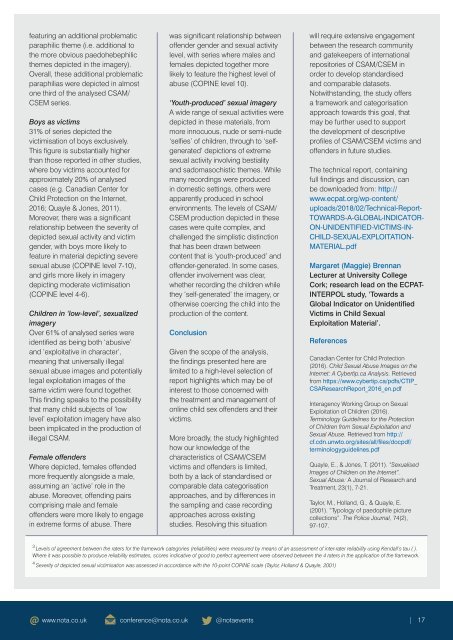NOTA News Newsletter July 2018 1
Create successful ePaper yourself
Turn your PDF publications into a flip-book with our unique Google optimized e-Paper software.
featuring an additional problematic<br />
paraphilic theme (i.e. additional to<br />
the more obvious paedohebephilic<br />
themes depicted in the imagery).<br />
Overall, these additional problematic<br />
paraphilias were depicted in almost<br />
one third of the analysed CSAM/<br />
CSEM series.<br />
Boys as victims<br />
31% of series depicted the<br />
victimisation of boys exclusively.<br />
This figure is substantially higher<br />
than those reported in other studies,<br />
where boy victims accounted for<br />
approximately 20% of analysed<br />
cases (e.g. Canadian Center for<br />
Child Protection on the Internet,<br />
2016; Quayle & Jones, 2011).<br />
Moreover, there was a significant<br />
relationship between the severity of<br />
depicted sexual activity and victim<br />
gender, with boys more likely to<br />
feature in material depicting severe<br />
sexual abuse (COPINE level 7-10),<br />
and girls more likely in imagery<br />
depicting moderate victimisation<br />
(COPINE level 4-6).<br />
Children in ‘low-level’, sexualized<br />
imagery<br />
Over 61% of analysed series were<br />
identified as being both ‘abusive’<br />
and ‘exploitative in character’,<br />
meaning that universally illegal<br />
sexual abuse images and potentially<br />
legal exploitation images of the<br />
same victim were found together.<br />
This finding speaks to the possibility<br />
that many child subjects of ‘low<br />
level’ exploitation imagery have also<br />
been implicated in the production of<br />
illegal CSAM.<br />
Female offenders<br />
Where depicted, females offended<br />
more frequently alongside a male,<br />
assuming an ‘active’ role in the<br />
abuse. Moreover, offending pairs<br />
comprising male and female<br />
offenders were more likely to engage<br />
in extreme forms of abuse. There<br />
was significant relationship between<br />
offender gender and sexual activity<br />
level, with series where males and<br />
females depicted together more<br />
likely to feature the highest level of<br />
abuse (COPINE level 10).<br />
‘Youth-produced’ sexual imagery<br />
A wide range of sexual activities were<br />
depicted in these materials, from<br />
more innocuous, nude or semi-nude<br />
‘selfies’ of children, through to ‘selfgenerated’<br />
depictions of extreme<br />
sexual activity involving bestiality<br />
and sadomasochistic themes. While<br />
many recordings were produced<br />
in domestic settings, others were<br />
apparently produced in school<br />
environments. The levels of CSAM/<br />
CSEM production depicted in these<br />
cases were quite complex, and<br />
challenged the simplistic distinction<br />
that has been drawn between<br />
content that is ‘youth-produced’ and<br />
offender-generated. In some cases,<br />
offender involvement was clear,<br />
whether recording the children while<br />
they ‘self-generated’ the imagery, or<br />
otherwise coercing the child into the<br />
production of the content.<br />
Conclusion<br />
Given the scope of the analysis,<br />
the findings presented here are<br />
limited to a high-level selection of<br />
report highlights which may be of<br />
interest to those concerned with<br />
the treatment and management of<br />
online child sex offenders and their<br />
victims.<br />
More broadly, the study highlighted<br />
how our knowledge of the<br />
characteristics of CSAM/CSEM<br />
victims and offenders is limited,<br />
both by a lack of standardised or<br />
comparable data categorisation<br />
approaches, and by differences in<br />
the sampling and case recording<br />
approaches across existing<br />
studies. Resolving this situation<br />
will require extensive engagement<br />
between the research community<br />
and gatekeepers of international<br />
repositories of CSAM/CSEM in<br />
order to develop standardised<br />
and comparable datasets.<br />
Notwithstanding, the study offers<br />
a framework and categorisation<br />
approach towards this goal, that<br />
may be further used to support<br />
the development of descriptive<br />
profiles of CSAM/CSEM victims and<br />
offenders in future studies.<br />
The technical report, containing<br />
full findings and discussion, can<br />
be downloaded from: http://<br />
www.ecpat.org/wp-content/<br />
uploads/<strong>2018</strong>/02/Technical-Report-<br />
TOWARDS-A-GLOBAL-INDICATOR-<br />
ON-UNIDENTIFIED-VICTIMS-IN-<br />
CHILD-SEXUAL-EXPLOITATION-<br />
MATERIAL.pdf<br />
Margaret (Maggie) Brennan<br />
Lecturer at University College<br />
Cork; research lead on the ECPAT-<br />
INTERPOL study, ‘Towards a<br />
Global Indicator on Unidentified<br />
Victims in Child Sexual<br />
Exploitation Material’.<br />
References<br />
Canadian Center for Child Protection<br />
(2016). Child Sexual Abuse Images on the<br />
Internet: A Cybertip.ca Analysis. Retrieved<br />
from https://www.cybertip.ca/pdfs/CTIP_<br />
CSAResearchReport_2016_en.pdf<br />
Interagency Working Group on Sexual<br />
Exploitation of Children (2016).<br />
Terminology Guidelines for the Protection<br />
of Children from Sexual Exploitation and<br />
Sexual Abuse. Retrieved from http://<br />
cf.cdn.unwto.org/sites/all/files/docpdf/<br />
terminologyguidelines.pdf<br />
Quayle, E., & Jones, T. (2011). “Sexualised<br />
Images of Children on the Internet”.<br />
Sexual Abuse: A Journal of Research and<br />
Treatment, 23(1), 7-21.<br />
Taylor, M., Holland, G., & Quayle, E.<br />
(2001). “Typology of paedophile picture<br />
collections”. The Police Journal, 74(2),<br />
97-107.<br />
3 Levels of agreement between the raters for the framework categories (reliabilities) were measured by means of an assessment of inter-rater reliability using Kendall’s tau (τ).<br />
Where it was possible to produce reliability estimates, scores indicative of good to perfect agreement were observed between the 4 raters in the application of the framework.<br />
4 Severity of depicted sexual victimisation was assessed in accordance with the 10-point COPINE scale (Taylor, Holland & Quayle, 2001)<br />
www.nota.co.uk conference@nota.co.uk @notaevents<br />
| 17





